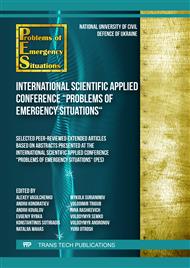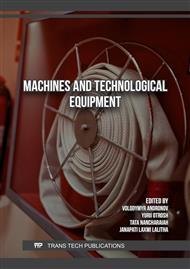[1]
W. Zheng, X. Zhang, Z. Wang, Experiment study of performances of fire detection and fire extinguishing systems in a subway train. Procedia Engineering, 135 (2016) 393–402.
DOI: 10.1016/j.proeng.2016.01.147
Google Scholar
[2]
A. Panchenko et al., Designing the flow-through parts of distribution systems for the PRG series planetary hydraulic motors. Eastern-EuropeanJournalofEnterpriseTechnologies, 3/1(93) (2018) 67–77.
DOI: 10.15587/1729-4061.2018.132504
Google Scholar
[3]
O. Nuianzin, S. Pozdieiev, V. Hora, A. Shvydenko, T. Samchenko, Experimental study of temperature mode of a fire in a cable tunnel. Eastern-European Journal of Enterprise Technologies, 3/10 (93) (2018) 21–27.
DOI: 10.15587/1729-4061.2018.131792
Google Scholar
[4]
S Vambol, V. Vambol, Khadeeja Abees Hmood Al-Khalidy, Experimental study of the effectiveness of water-air suspension to prevent an explosion. Journal of Physics: Conference Series, 1294/7 (2019) 072009.
DOI: 10.1088/1742-6596/1294/7/072009
Google Scholar
[5]
A. Kovalov, V. Konoval, A. Khmyrova, K. Dudko, Parameters for simulation of the thermal state and fire-resistant quality of hollow-core floors used in the mining industry. E3S Web of Conferences, 123 (2019) 01022.
DOI: 10.1051/e3sconf/201912301022
Google Scholar
[6]
D. Dubinin et al., Experimental Investigations of the Thermal Decomposition of Wood at the Time of the Fire in the Premises of Domestic Buildings. Materials Science Forum, 1066, (2022) 191–198.
DOI: 10.4028/p-8258ob
Google Scholar
[7]
S. Ragimov et al., Physical modelling of changes in the energy impact on a worker taking into account high-temperature radiation. Journal of Achievements in Materials and Manufacturing Engineering, 1/91 (2018) 27–33.
DOI: 10.5604/01.3001.0012.9654
Google Scholar
[8]
B. Pospelov et al., Mathematical model of determining a risk to the human health along with the detection of hazardous states of urban atmosphere pollution based on measuring the current concentrations of pollutants. Eastern-European Journal of Enterprise, 4/10 (106) (2020) 37–44.
DOI: 10.15587/1729-4061.2020.210059
Google Scholar
[9]
V. Sadkovyi et al., Construction of a method for detecting arbitrary hazard pollutants in the atmospheric air based on the structural function of the current pollutant concentrations. Eastern-European Journal of Enterprise, 6/10 (108) (2020) 14–22.
DOI: 10.15587/1729-4061.2020.218714
Google Scholar
[10]
S. Vambol, V. Vambol, I. Bogdanov, Y. Suchikova, N. Rashkevich, Research of the influence of decomposition of wastes of polymers with nano inclusions on the atmosphere. Eastern-European Journal of Enterprise Technologies, 6/10 (90) (2017) 57–64.
DOI: 10.15587/1729-4061.2017.118213
Google Scholar
[11]
B. Pospelov et al., Development of the correlation method for operative detection of recurrent states. Eastern-European Journal of Enterprise, 6/4 (102) (2019) 39–46.
DOI: 10.15587/1729-4061.2019.187252
Google Scholar
[12]
A. Kovalov, Y. Otrosh, S. Vedula, O. Danilin, T. Kovalevska, Parameters of fire-retardant coatings of steel constructions under the influence of climatic factors. Naukovyi Visnyk Natsionalnoho Hirnychoho Universytetu, 3 (2019) 46–53.
DOI: 10.29202/nvngu/2019-3/9
Google Scholar
[13]
O. Nekora, V. Slovynsky, S. Pozdieiev, The research of bearing capacity of reinforced concrete beam with use combined experimental-computational method. MATEC Web of Conferences, 116 (2017) 02024.
DOI: 10.1051/matecconf/201711602024
Google Scholar
[14]
D. Dubinin et al., Numerical simulation of the creation of a fire fighting barrier using an explosion of a combustible charge. Eastern-European Journal of Enterprise Technologies, 6/10 (90), (2017) 11– 16.
DOI: 10.15587/1729-4061.2017.114504
Google Scholar
[15]
D. Dubinin et al., Research and justification of the time for conducting operational actions by fire and rescue units to rescue people in a fire. Sigurnost, 64 (1) (2022) 35–46.
DOI: 10.31306/s.64.1.5
Google Scholar
[16]
A. Semko, O. Rusanova, O. Kazak, M. Beskrovnaya, S. Vinogradov, I. Gricina, The use of pulsed high-speed liquid jet for putting out gas blow-out. International Journal of Multiphysics, 9/1 (2015) 9–20.
DOI: 10.1260/1750-9548.9.1.9
Google Scholar
[17]
D. Dubinin et al., Investigation of the effect of carbon monoxide on people in case of fire in a building, Sigurnost, 62 (4) (2020) 347– 357.
DOI: 10.31306/s.62.4.2
Google Scholar
[18]
D. Du, X. Pan, M. Hua, Experimental study on fire extinguishing properties of compound superfine powder. Procedia Engineering, 218 (2018) 142-148. DOI: 10.1016/j.proeng. 2017.12.126.
DOI: 10.1016/j.proeng.2017.12.126
Google Scholar
[19]
D. Dubinin et al., Improving the installation for fire extinguishing with finely-dispersed water. Eastern-European Journal of Enterprise Technologies, 2/10 (92) (2018) 38–43.
DOI: 10.15587/1729-4061.2018.127865
Google Scholar
[20]
K. Korytchenko et al., Experimental investigation of the fire-extinguishing system with a gas-detonation charge for fluid acceleration. Eastern-European Journal of Enterprise Technologies, 3/5 (93), (2018) 47–54.
DOI: 10.15587/1729-4061.2018.134193
Google Scholar
[21]
М. Gurbanova, V. Loboichenko, N. Leonova, V. Strelets, R. Shevchenko, Comparative assessment of the ecological characteristics of auxiliary organic compounds in the composition of foaming agents used for fire fighting. Bulletin of the Georgian National Academy of Sciences, 14/4, (2020) 58–66.
Google Scholar
[22]
A. Chernukha, A. Teslenko, P. Kovalov, O. Bezuglov, Mathematical Modeling of Fire-Proof Efficiency of Coatings Based on Silicate Composition. Materials Science Forum, 1006 (2020) 70–75.
DOI: 10.4028/www.scientific.net/MSF.1006.70
Google Scholar
[23]
I Dadashovet al., Simulation of the insulating properties of two-layer material. Functional Materials, 25(4) (2018) 774–779.
DOI: 10.15407/fm25.04.774
Google Scholar
[24]
A. Kireev et al., Study insulating and cooling properties of the material on the basis of crushed foam glass and determination of its extinguishing characteristics with the attitude to alcohols. Materials Science Forum, 1006 (2020) 62–69. DOI: 10.4028/ www.scientific.net/MSF.1006.62.
DOI: 10.4028/www.scientific.net/msf.1006.62
Google Scholar
[25]
A. Chernukhaet al., Thermodynamic study of fire-protective material. Materials Science Forum, 1038 (2021) 486–491.
DOI: 10.4028/www.scientific.net/MSF.1038.486
Google Scholar
[26]
A. Savchenko et al., Rezul'taty kompleksnogo issledovanija ognetushashhejj effektivnosti geleobrazujushhih system dlja tushenija pozharov v zhilyh zdanijah. Problemy pozharnoj bezopasnosti, 35 (2014) 188–193.
Google Scholar
[27]
A. Kireev, Issledovanie ognetushashhego dejstvija geleobrazujushih sostavov na model'nyh ochagah pozharov klassa A iz DVP i DSP. Problemy pozharnoj bezopasnosti, 30 (2011) 83–88.
Google Scholar
[28]
K. Ostapov et al., Improvement of the installation with an extended barrel of cranked type used for fire extinguishing by gel-forming compositions. Eastern-European Journal of Enterprise Technologies, 4/10 (100) (2019) 30–36.
DOI: 10.15587/1729-4061.2019.174592
Google Scholar
[29]
V. Tiutiunyk et al., System approach for readiness assessment units of civil defense to actions at emergency situations. Naukovyi Visnyk Natsionalnoho Hirnychoho Universytetu, 1 (2018) 99–105.
DOI: 10.29202/nvngu/2018-1/7
Google Scholar
[30]
K. Ostapov et al., Improving the Quenching of the Undercarriage Space Due to the Adhesive Properties of Gel-Forming Compositions. Key Engineering Materials, 927 (2022) 53–62.
DOI: 10.4028/p-1su80t
Google Scholar
[31]
O. Kondratenko et al., Mathematical model of the efficiency of diesel particulate matter filter. Naukovyi Visnyk Natsionalnoho Hirnychoho Universytetu, 6 (2015) 55–61.
Google Scholar



